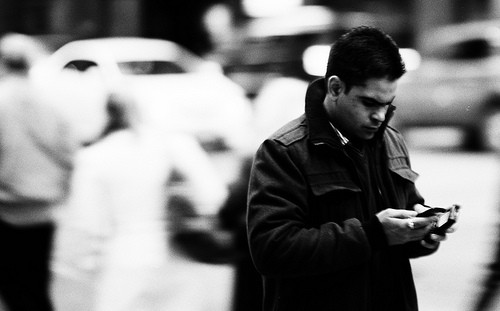The University of Houston is warning its students of the dangers of distracted walking. Yes, you read that right — pedestrians are the most vulnerable group to use the road, and distracted walking is a major contributing factor. In fact, according to the National Highway Traffic Safety Administration (NHTSA), pedestrians were one of the few groups of road users to incur an increase in fatalities in the United States in 2011, with a total of 4,432 deaths.

The NHTSA is warning against the dangers of distracted… walking? Really? From Dawsean.
According to the Daily Cougar, the student newspaper, many University of Houston students are at risk because they are prey to distractions, like texting and using smartphones. One of the school’s safety officers, Yolanda Edmund, said, “The reason why pedestrian accidents occur is because students are not alert, which makes them a bigger target. UHPD advises everyone to be more alert on campus while walking.”
Yet the problem isn’t only limited to distracted students. Who hasn’t been trapped behind a slow-moving texter while walking down a busy street? Unfortunately, this common annoyance can also pose fatal repercussions. Back in August of this year, NHTSA launched the “Everyone is a Pedestrian” campaign to help reduce the number of pedestrian injuries and fatalities. The threat is very real: As of 2011 data, every two hours, a pedestrian is killed in a traffic crash; during that same period, 15 pedestrians are injured.
Aside from the known risk from errant vehicles, pedestrians often put themselves at risk. According to the New York Times, more than 1,000 pedestrians visited emergency rooms in 2008 after they were injured while using a phone to talk or text, and that figure has doubled since 2006, based on an Ohio State University study. Other statistics demonstrate that injuries caused by mobile phone distraction and necessitating an emergency room visit increased from 559 in 2004 to 1,500 in 2010, in the United States.
Though the incidents are often laughably outrageous, they’re also dangerous. Explains Oliver Burkeman for The Guardian, “Some victims walked off bridges, or into moving traffic; around two-thirds of the victims were under 25. Last year, a Los Angeles man was so busy texting he almost walked into a bear, while in Indiana a woman strolled straight into an icy river. The year before, a woman in Pennsylvania fell into a shopping mall fountain for related reasons – then threatened to sue the mall.”
While walking and texting seems a simple task, it actually requires intense concentration. “We’re not wired to multitask well,” Earl Miller, a neuroscientist at the Massachusetts Institute of Technology, told CNN in an interview last year. “So when people think they’re multitasking, they’re actually just switching from one task to another very rapidly. And every time they do, there’s a cognitive cost in doing so.”
Contrary to popular belief, the brain must “pick and choose” which data to pay attention to, and as a result, potential warnings may be lost. “The danger is that you don’t see what’s coming,” said Miller. “The same constraints that make it a bad idea to text while you drive make it a bad idea to text while you walk.”